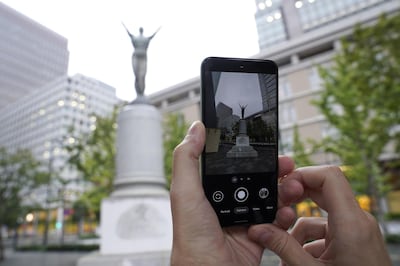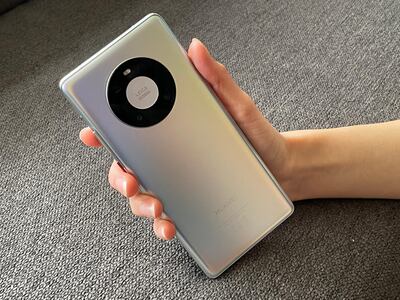From stargazing to Minecraft-ing, smartphones have countless capabilities. But these days, they're all about the camera. As models slowly converge towards the same form, with roughly the same appearance and functionality, it's the potential and the promise of their built-in cameras that drives sales and prompts us to upgrade.
Over the past couple of years, the race to cram in bigger lenses and more powerful features has gathered pace. Samsung, Google, Huawei and Apple are engaged in a vigorous game of one-upmanship, all working to create the phone which produces the best photographs in low light, or the best slow-motion video.
These technological strides are leading to all kinds of other uses for those cameras, from augmented reality to monitoring our health. With our lives increasingly mediated through lenses, it’s little wonder that smartphone cameras have become the focus of our attention.
The most frequently asked question: which is the best? The technology may be complex, but the answer is relatively simple: the largest, more expensive smartphones are the ones that pack the biggest punch. Yes, brilliant photos can be taken with smaller phones, but the bigger ones will always give you the edge.
The current front runners are the iPhone 12 Pro Max and the Samsung Galaxy S21 Ultra, both hulking brutes of phones – but they’re big for a reason; the multiple lenses and sensors take up physical space which the housing needs to accommodate. Modern smartphones are big on miniaturisation – every millimetre counts – but some things just can’t be made any smaller.
Now that we’re getting used to the so-called “bump” – the protrusion on the rear of modern smartphones which houses the lenses – manufacturers are making them work even harder.
The iPhone 12 Pro Max’s bump has three lenses – wide, ultrawide and telephoto – while the S21 Ultra has four, with an extra telephoto chucked in for good measure.
Samsung’s zoom capabilities have been ahead of Apple’s for some time; the S21 Ultra’s predecessor, the S20 Ultra, featured a periscope lens whose elements physically move to achieve 5x optical zoom, and the S21 Ultra has bumped that up to 10x. Meanwhile, the iPhone 12 Pro and 12 Pro Max lag behind at 2x and 2.5x respectively. (Periscope lenses are rumoured to be coming to iPhones in 2022.)
But it’s not all about the lenses. Choosing a smartphone camera with the greatest zoom capabilities or megapixel count isn’t necessarily a bad strategy, but it’s the camera sensor that does the heavy lifting, taking the light that arrives through the lens and using it to produce digital images.
The bigger the sensor, the more light is let in, allowing you to take pictures in poor light with a greater level of detail. The ever-growing dimensions of smartphones (which we reported on a couple of weeks ago) have allowed larger sensors to produce results comparable with standalone compact cameras.
Code also plays a massive role in producing crystal clear images. Elements such as colour tone, brightness, saturation and sharpness are controlled by software, whose default settings are particular to each manufacturer and model.
Samsung is known to conduct global surveys of customers to collate personal preferences, the results of which are fed back into its software. A side-by-side comparison of iPhone, Google and Samsung phones conducted by the website MacRumors back in December showed that outdoors, daytime images tended to look slightly cooler and bluer on the iPhone – but ultimately it’s a question of taste, and you always have the option to adjust colour elements after the fact.
Software also powers so-called “portrait mode”, found on all high-end smartphones, which simulates the photos you get from professional cameras with wide apertures. That effect, known as bokeh, where the background of the image is blurred and the subject in the foreground is sharply in focus, may only be simulated, but that mimicry has become incredibly convincing.
Night mode, video stabilisation, macro modes for close-up images, even virtual assistants to enable you to take photos with voice commands – these are all areas where software is in rapid development and fierce competition. In some cases, such as the Google Pixel 5, the quality of the software can almost compensate for lower-specification sensors and lenses.
More innovations are on their way. Built-in three-axis gimbals, enabling smooth video capture without shaking or vibration, have already been incorporated into smartphones produced by Chinese company Vivo.
There are rumours that future iPhones will incorporate five or even seven lenses in the not-too-distant future, while Samsung has just unveiled its most recent sensor, the Dual Pixel Pro, which improves auto-focus and light sensitivity even further. Cameras will gain new uses as software advances; one imminent update for Android will enable us to use them to track our pulse and respiratory rate.
In truth, these cameras will never have the power and capability of the best compacts or DSLRs. Their selling point is their accessibility; we always have them around, so they’re always available to capture the moments that matter. But the images they produce can be undeniably beautiful.
Last month, the winner of the 10th Annual Mobile Photography awards, Chinese photographer Dan Liu, worked his magic with an iPhone 11 Pro Max. The award’s founder, Daniel Berman, spoke of the contest as “a testament to another year in the rapid evolution of mobile phone cameras.” They’re only going to get better.
Here's our list of the five smartphones with the best cameras currently on the market:
1. Samsung Galaxy S21 Ultra
2. iPhone 12 Pro Max
3. Huawei Mate 40 Pro
4. Sony Xperia 1 II
5. Google Pixel 5
1. Samsung Galaxy S21 Ultra
With four rear cameras – including two telephotos – and a top-end spec throughout, the S21 Ultra is hard to beat. It's also huge (with a 6.8-inch screen) and expensive. But hey, you get what you pay for. Notable features: a crystal-clear 10x optical zoom, and a Director’s View mode which allows filming with front and rear cameras simultaneously.
2. iPhone 12 Pro Max
It's also large and pricey, but it's the best camera to have rolled off Apple's production line. It has a lower zoom capability than the Samsung, but exemplary performance in low light and cunning software (HDR3) which compiles the best picture possible from multiple exposures.
3. Huawei Mate 40 Pro
Huawei phones have been hobbled ever since the May 2019 ban issued by former president Donald Trump, which prevented Huawei from doing business with any US organisation, including Google. But while it may be short on software, the cameras are uncompromised. The Mate 40 Pro is an excellent all-round performer, with a particularly high-spec front camera (13 megapixels) and even a dedicated mode for photographing the Moon.
4. Sony Xperia 1 II
The Experia 1 II is all about the video, with exceptional focus, detailed pictures and the ability to shoot at a 21:9 ratio, for a true cinema-style experience. An app called Cinema Pro also helps edit as you go. But the camera is excellent, too – particularly if you switch to manual mode, which offers a range of options you'd associate with Sony's standalone camera range, the Alpha.
5. Google Pixel 5
It's cheaper than the others, and the camera spec doesn't look as good on paper, but there's something going on under the hood that takes its two rear lenses and does something quite magical with them, generating crisp pictures with accurate colour and exceptional autofocus. A bargain.








